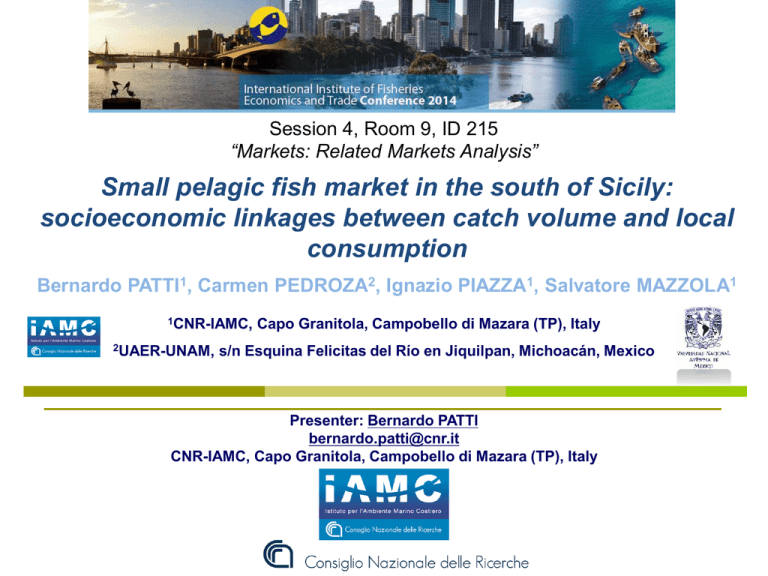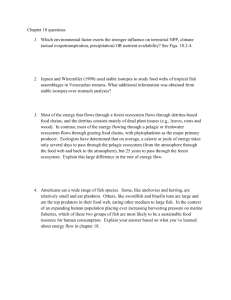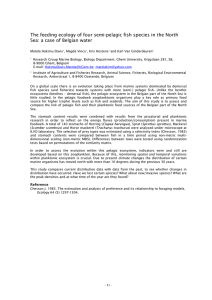Small pelagic fish market in the south of Sicily:
advertisement

Session 4, Room 9, ID 215 “Markets: Related Markets Analysis” Small pelagic fish market in the south of Sicily: socioeconomic linkages between catch volume and local consumption Bernardo PATTI1, Carmen PEDROZA2, Ignazio PIAZZA1, Salvatore MAZZOLA1 1CNR-IAMC, 2UAER-UNAM, Capo Granitola, Campobello di Mazara (TP), Italy s/n Esquina Felicitas del Río en Jiquilpan, Michoacán, Mexico Presenter: Bernardo PATTI bernardo.patti@cnr.it CNR-IAMC, Capo Granitola, Campobello di Mazara (TP), Italy RESEARCH OBJECTIVE: To analyze the links between anchovy landings by pelagic pair trawlers and their market price from data collected in Sciacca harbor (Central Mediterranean Sea, Strait of Sicily) throughout the period 1999-2013. Session 4.7, Room Z306, ID 215 “Markets: Related Markets Analysis” IIFET 2014 Brisbane, 7-11 July 2014 INTRODUCTION Along the southern Sicilian coast (Central Mediterranean Sea), Sciacca harbor is the most important landing site for small pelagic fish species. It accounts for about 2/3 of total catch (mainly anchovies and sardines) in GFCMFAO Geographical Sub-Area 16 (South of Sicily). Two operational units (OUs) are presently active: purse seiners (PS) and pelagic pair trawlers (PT). The GSA16 fleet is composed by about 50 units (17 purse seiners and 30 pelagic pair trawlers; census data, December 2006). About 10 PS e 16 PT are based in Sciacca port. For both OUs, anchovy represents the main target species due to the higher market price. Session 4.7, Room Z306, ID 215 “Markets: Related Markets Analysis” G.S.A. 16 STUDY AREA IIFET 2014 Brisbane, 7-11 July 2014 SCIACCA port Session 4.7, Room Z306, ID 215 “Markets: Related Markets Analysis” IIFET 2014 Brisbane, 7-11 July 2014 Small pelagic fisheries Commercial species: Sardine (Sardina pilchardus) Anchovy (Engraulis encrasicolus) Session 4.7, Room Z306, ID 215 “Markets: Related Markets Analysis” IIFET 2014 Brisbane, 7-11 July 2014 Sardine (Sardina pilchardus) Small pelagic fish Covered with scales Maximum length: 25 cm Common length: 18 cm Session 4.7, Room Z306, ID 215 “Markets: Related Markets Analysis” IIFET 2014 Brisbane, 7-11 July 2014 Anchovy (Engraulis encrasicolus) Small pelagic fish Maximum length: 20 cm Common length: 13 cm Average life: 4 years Session 4.7, Room Z306, ID 215 “Markets: Related Markets Analysis” IIFET 2014 Brisbane, 7-11 July 2014 Purse seine Characteristics Overview: Encircling fishing net. In general purse seine is the most efficient gear to catch large and small pelagic species that are shoaling. Fishing Operation: Searching Checking and evaluating Set the net around the fish Closing and hauling Target Species: Aggregated pelagic species (schools) of all sizes from small sardines to the large tunas. Impacts: No impact on the bottom habitat (except in shallow waters when the gear wipes the sea bottom). Main negative impact: bycatch of dolphins in certain fishing areas. Special techniques have been developed to reduce it. Session 4.7, Room Z306, ID 215 “Markets: Related Markets Analysis” IIFET 2014 Brisbane, 7-11 July 2014 Pelagic pair trawl Characteristics Fishing Gear: A midwater fishing net pulled through the water behind two boats. Fishing Operations: Search for fish (echosounder and sonar) Location, size and determination Paying out the net Towing Hauling Transfer on board Impacts: Almost mono -species fishery. No impact on bottom habitat and bottom structure. Discards higher than purse seine. Bycatch rates are generally low. Some incidental catch of dolphins or other marine mammals. Session 4.7, Room Z306, ID 215 “Markets: Related Markets Analysis” IIFET 2014 Brisbane, 7-11 July 2014 Small pelagic fishing: Purse seine (with light attraction) Anchovy fisheries is very old, it was practiced as early as eighteenth century with the so-called “Vacchi ri Sadda", vessels with lateen sails. Fishing for small pelagic fish with purse seine is considered one of the most sustainable systems, because it does not affect the marine ecosystem and helps the rebuiding of fish stocks thanks to seasonality; fishing is practiced, in fact, A fishing boat with purse seine system from March to November. leaving the harbor Session 4.7, Room Z306, ID 215 “Markets: Related Markets Analysis” IIFET 2014 Brisbane, 7-11 July 2014 Small pelagic fishing: Purse seine (with light attraction) Small supporting boats equipped with F.A.D. (lights) Session 4.7, Room Z306, ID 215 “Markets: Related Markets Analysis” IIFET 2014 Brisbane, 7-11 July 2014 Purse seine (with light attraction) A fishing trip begins in the evening. After identifying the fish, lamps are lowered into the sea, so attracting the fish. When fish aggregate below the lamps, the net is lowered into the sea, forming a circle and enclosing the fish into the net. Session 4.7, Room Z306, ID 215 “Markets: Related Markets Analysis” IIFET 2014 Brisbane, 7-11 July 2014 Purse seine (with light attraction) Catch of small pelagic fish Session 4.7, Room Z306, ID 215 “Markets: Related Markets Analysis” IIFET 2014 Brisbane, 7-11 July 2014 Purse seine (with light attraction) Fish caught in the net are put on board Session 4.7, Room Z306, ID 215 “Markets: Related Markets Analysis” IIFET 2014 Brisbane, 7-11 July 2014 Purse seine (with light attraction) Fish are then put in big boxes with ice and water Session 4.7, Room Z306, ID 215 “Markets: Related Markets Analysis” IIFET 2014 Brisbane, 7-11 July 2014 Purse seine (with light attraction) Finally, fish are placed in smaller boxes ready for sale Session 4.7, Room Z306, ID 215 “Markets: Related Markets Analysis” IIFET 2014 Brisbane, 7-11 July 2014 Pelagic pair trawl: Operated during daytime on fish schools In contrast with purse seine, no seasonality Session 4.7, Room Z306, ID 215 “Markets: Related Markets Analysis” IIFET 2014 Brisbane, 7-11 July 2014 Processing of anchovies: Head removing Salting Filleting Head removing Salting Session 4.7, Room Z306, ID 215 “Markets: Related Markets Analysis” Filleting IIFET 2014 Brisbane, 7-11 July 2014 Fillets in glass jars In spite that small pelagic fishes are quite appreciated for direct fresh consumption, landings are always totally absorbed by local transformation (canning) companies’ high demand. Olive oil filling Local consumption of fresh fish is low, because small pelagic fish are considered relatively “poor” when compared to the wide fish variety in Sciacca market. Session 4.7, Room Z306, ID 215 “Markets: Related Markets Analysis” IIFET 2014 Brisbane, 7-11 July 2014 D.O.P. Brand ("Protected Designation of Origin“, PDO) Product brand is going to be approved by the European Commission D.O.P. means: More controls Higher quality Consumer safety Session 4.7, Room Z306, ID 215 “Markets: Related Markets Analysis” IIFET 2014 Brisbane, 7-11 July 2014 Market data The Sciacca fish processing industry produces about 5,000 tons of small pelagic fish each year The annual business cycle is about € 30,000,000 More than 1,000 people work in the fish processing industry Session 4.7, Room Z306, ID 215 “Markets: Related Markets Analysis” IIFET 2014 Brisbane, 7-11 July 2014 MATERIALS AND METHODS Line Plot (Spreadsheet0.sta 6v*178c) 28 90 26 80 24 22 70 20 60 18 16 50 14 40 12 10 30 8 20 6 4 10 2 Session 4.7, Room Z306, ID 215 “Markets: Related Markets Analysis” Mar-2013 Mar-2012 Mar-2011 Mar-2010 Mar-2009 Mar-2008 Mar-2007 Mar-2006 Mar-2005 Mar-2004 Mar-2003 Mar-2002 0 Mar-2001 0 Mar-2000 This study analyzes the relationship between anchovy landings from pelagic pair trawlers and their market price from daily catch/price data collected in Sciacca harbor throughout the period March 1999 - December 2013. Data were obtained by on the dock interviews. Average monthly values for both the time series were firstly evaluated to the aims of the present study. Mar-1999 Ave_catch_tons(L) Price_euro(R) IIFET 2014 Brisbane, 7-11 July 2014 MATERIALS AND METHODS Both time series show a seasonal signal (more evident in the landings series, most probably linked to the ecology of the species, which spawns in coastal areas from March to September), and a significant trend, increasing for landings and decreasing for prices. Line Plot (Spreadsheet0.sta 6v*178c) 28 90 26 80 24 22 70 20 60 18 16 50 14 40 12 10 30 8 20 6 4 10 2 Mar-2013 Mar-2012 Mar-2011 Mar-2010 Mar-2009 Mar-2008 Mar-2007 Mar-2006 Mar-2005 Mar-2004 Mar-2003 Mar-2002 Mar-2001 Mar-2000 0 Mar-1999 0 Ave_catch_tons(L) Price_euro(R) Inflation adjustment was applied on the price time series (during the considered period the rise in the inflation index was +38.4%). Session 4.7, Room Z306, ID 215 “Markets: Related Markets Analysis” IIFET 2014 Brisbane, 7-11 July 2014 RESULTS In the two figures below a 12-month moving average is superimposed, in order to emphasize the general evolution in the series and better investigate on changes in the relationship between prices and landings over time. In particular, the moving average is able to remove seasonal signals from both the series. The two series appear to be generally anticorrelated, and an apparent 67 year long cycle in landings is also evidenced. LANDINGS MARKET PRICES 90 30 y = 0.0016x - 54.676 R² = 0.3567 25 20 80 y = -0.0065x + 285 R² = 0.6931 70 60 50 MM12 15 monthly catch Lineare (MM12) 10 Price 40 MM12 Lineare (MM12) 30 20 5 10 set-13 set-12 mar-13 set-11 mar-12 set-10 mar-11 set-09 mar-10 set-08 mar-09 set-07 mar-08 set-06 mar-07 set-05 mar-06 set-04 mar-05 set-03 mar-04 set-02 mar-03 set-01 mar-02 set-00 mar-01 set-99 mar-00 mar-99 0 set-13 set-12 mar-13 set-11 mar-12 set-10 mar-11 set-09 mar-10 set-08 mar-09 set-07 mar-08 set-06 mar-07 set-05 mar-06 set-04 mar-05 set-03 mar-04 set-02 mar-03 set-01 mar-02 set-00 mar-01 set-99 mar-00 mar-99 0 As both the landings and the market prices exhibit a significant trend, in order to investigate on their relationship the two series were detrended before further analysis. Session 4.7, Room Z306, ID 215 “Markets: Related Markets Analysis” IIFET 2014 Brisbane, 7-11 July 2014 RESULTS The relationship between detrended landings and prices evidenced the presence of elasticity for prices, most marked during the Summer and the Autumn. Scatterplot (Spreadsheet0.sta 8v*178c) Season: winter Detrended_Ave_Price = -1.0558-0.4459*x Season: spring Detrended_Ave_Price = -1.8027-0.4413*x Season: summer Detrended_Ave_Price = -1.6099-0.8959*x Season: autumn Detrended_Ave_Price = 2.5994-0.8606*x 50 40 30 20 10 0 Detrended_Ave_Price -10 -20 -30 -15 -10 -5 0 5 10 15 20 25 Season: winter Season: spring Season: summer Season: autumn Detrended_Ave_Catch Session 4.7, Room Z306, ID 215 “Markets: Related Markets Analysis” IIFET 2014 Brisbane, 7-11 July 2014 The figure shows the relationship between the 12-month moving averages of the two time series (prices in vertical axis and landings in horizontal axis). It is possible to note three distinct “states” in the relationship. The first state, in the lower left corner, characterizes the first and the last years of the time series (1999-2001 and 2012-2013, respectively), when prices were relatively low. Most of the points falls in the intermediate level, characterizing most of the years from 2002 to 2011, with the only exception of years 2003-2004, when prices were relatively higher in relation to landings. The first transition from the lower state to the intermediate state corresponds to the change in currency from the Italian lira to Euro (2002). The sharp transition from the intermediate state to the upper state appears to be a further attempt, extended just for a couple of years (from mid 2003 to mid 2005) to increase profitability by increasing prices. Finally, the last recent transition (in late 2011) from the intermediate to the lower state corresponds to the start of the negative effects of the global crisis on the Italian economy. RESULTS AND DISCUSSION Scatterplot (Spreadsheet1.sta 6v*166c) 15 “Intermediate” years: 2002 and 2005-2011 “High”years: 2003-2004 10 5 0 Price-detrended-MM “Low” years: 1999-2001 and 2012-2013 -5 -10 -8 -6 -4 -2 0 2 4 6 Year: 1999 Year: 2000 Year: 2001 Year: 2002 Year: 2003 Year: 2004 Year: 2005 Year: 2006 Year: 2007 Year: 2008 Year: 2009 Year: 2010 Year: 2011 Year: 2012 Year: 2013 Weight-detrended-MM Session 4.7, Room Z306, ID 215 “Markets: Related Markets Analysis” IIFET 2014 Brisbane, 7-11 July 2014 CONCLUSIONS Sciacca fisheries represents a good example to understand and interpret the dynamics of price elasticity in relation to fish production and in response to economic situation and trends. The results of this study show, on one hand, the importance of fish production levels in modulating market prices. Conversely, the potential relevance of the price lever in modulating fish production demand is also evidenced. This effect may be used to manage fish consumption, e.g. to the aim of fostering the substitutions from unhealthy to healthy food such as blue fish. Session 4.7, Room Z306, ID 215 “Markets: Related Markets Analysis” IIFET 2014 Brisbane, 7-11 July 2014 Thank you for your attention! Session 4.7, Room Z306, ID 215 “Markets: Related Markets Analysis” IIFET 2014 Brisbane, 7-11 July 2014




